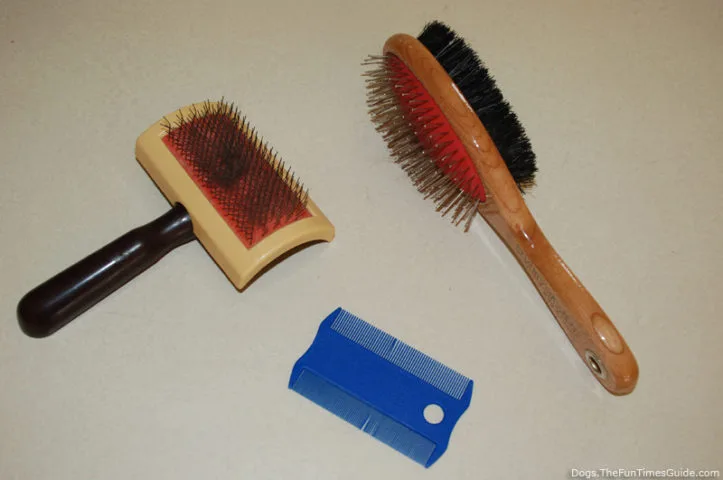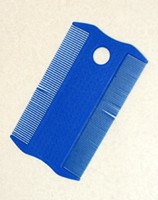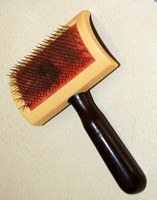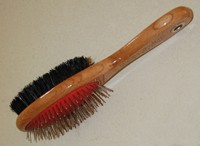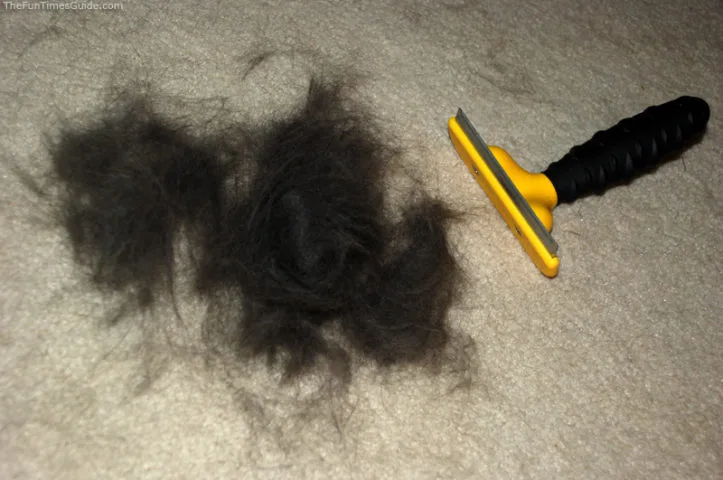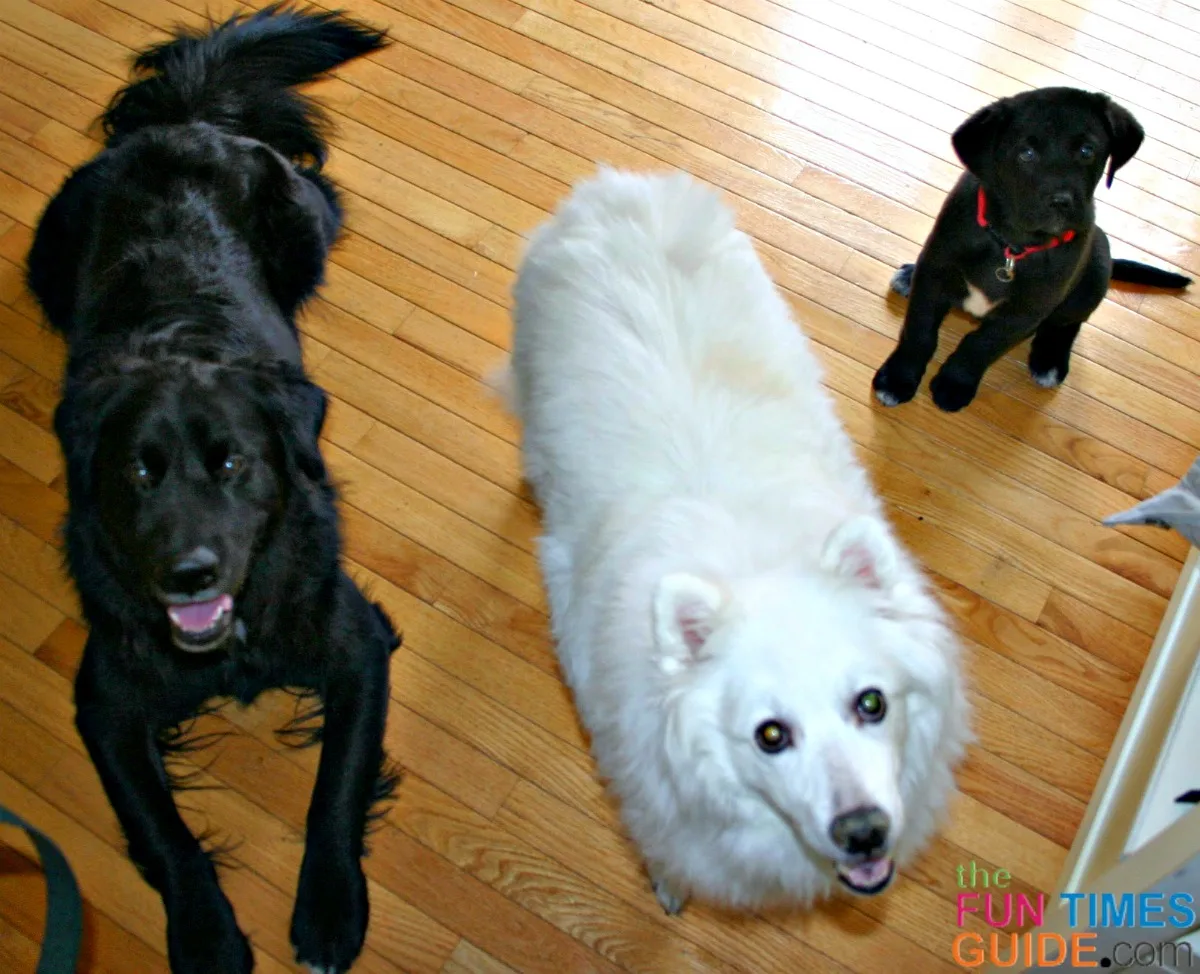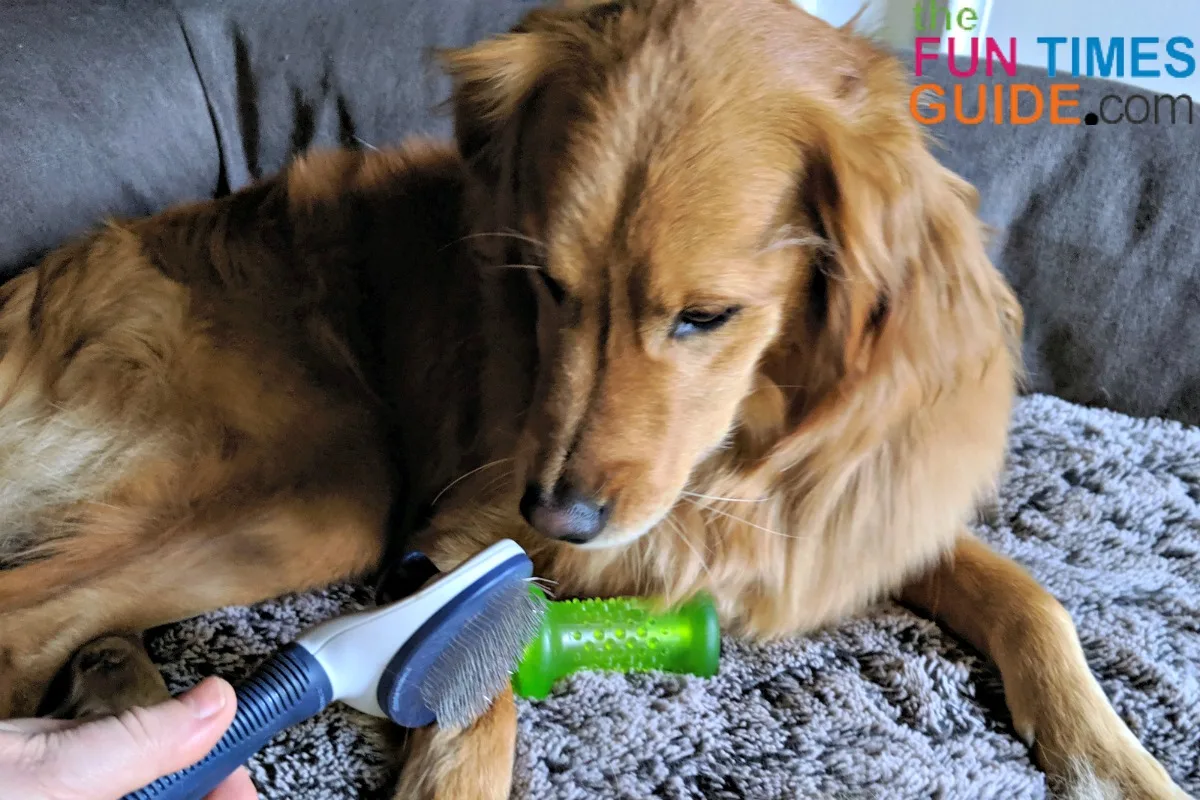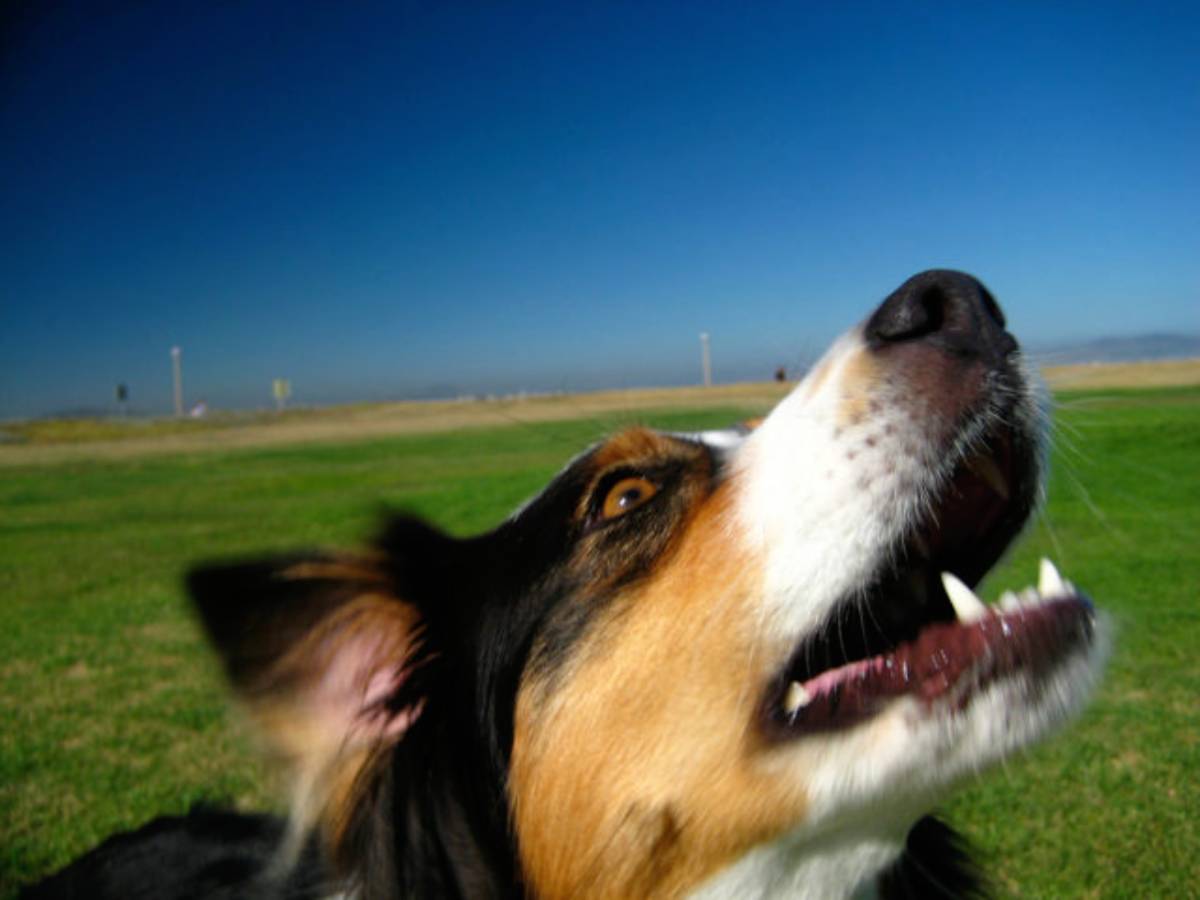I do all of my own dog grooming. I’ve used a variety of pet grooming brushes on small dogs, large dogs, short coats, long coats, and everything in between.
These are just some of the pet brushes that I’ve used in the past. In fact, these are the 3 grooming tools that I had used most recently to brush my dog, Tenor — a Labrador Retriever / Great Pyrenees mix.
Each of these grooming tools is different in some small way. Therefore, each serves a slightly different purpose.
However… I’ve found a pet brush that blows all 3 of those away! It’s called the Furminator deShedding tool.
I’ve been using the Furminator deShedding brush for years now, and without a doubt it’s my all-time favorite dog brush.
Here’s why…
My Old Dog Brushes
My dog sheds… a lot!
The reason I had 3 pet brushes that I used regularly (a few times a month) was because each one brushed my dog in a slightly different way.
For instance…
The small blue one is actually a flea comb (also used in many homes as a lice comb). While my dog has never had fleas, I used this brush for helping to easily remove ticks after walks in the woods. After noticing that it worked so well at pulling up loose hairs from my dog’s undercoat, I started using it regularly as a basic undercoat brush. Since it’s so small and is only made of plastic, it wasn’t all that effective. But, at the time, it was one of the best ways I had to remove loose undercoat fur. And if you have a dog with a thick undercoat, then you know how all of that super thin flyaway dog hair ends up in the corners of your house — unless you brush it out first. (Which is why the Furminator is so great.)
The rectangular curved small-tined pet brush was my favorite for a long time, because it had some sharpness to it and it worked great. The curve of the brush head made it sort of easy to glide along your dog’s body — with their natural curves and bends. And the stainless steel teeth of this slicker brush were so short & tiny, they felt sharp and super-grabby. Therefore, they got a lot more of the shedding hair on any one stroke of the dog’s coat. Before I tried the Furminator brush, I thought this was as good as it got in terms of dog brushes! Stay tuned to see how the Furminator blows this brush away.
The paddle-shaped pet brush with actual bristles on one side and metal tines on the other was pretty ineffective with my short hair Lab-mix dog. As far as “regular” brushes for shedding… pin and bristle brushes work better with long-haired dogs. This was simply a pet brush that I’d had leftover from my days with Jersey, our long-haired dog. The wide, spaced out tines work well on long-haired dogs. But the Furminator puts this dog brush to shame, as well.
NOW I know better…
My New Favorite Dog Brush Is The Furminator
The Furminator for dogs (and cats) is a different kind of pet brush. It grabs the hair like a comb, yet smooths the fur like a brush.
Here are some of the pros and cons of the Furminator dog brush that I have:
Furminator Brush Pro’s
- It always grabs lots of fur, so you feel you’re accomplishing something with every brush stroke
- It gets rid of the flyaways — those thin, loose hair from shedding that end up in the corners of your room, along the baseboards, and on the furniture
- It reduces the amount of hair shedding that takes place by removing it before it hits the floor and sticks to things around the house
- Less frequent vacuuming around the house is required
- My dog loves it (though, to be honest, he enjoys any type of brushing)
NOTE: I also own the large red Furminator dog brush that has a ‘fur ejector button’. I like it too. (It’s easier to clean — see how it’s done.) My yellow Furminator is the original model without a FURejector button on it. But now it looks like they’re adding the fur ejector button to all Furminator dog brushes these days. In my opinion, it’s not that big of a deal.
Furminator Brush Con’s
- Even though it has an ergonomic handle, it’s sort of clunky and has no “give” to it.
- You can really only brush in one direction as you’re using it.
- If you brush too hard, you could hurt your dog — because the bristles are actually teeny-tiny little blades (or teeth) that could possibly scratch your pet’s skin. However, when used properly, you’re actually helping to promote healthy skin and coat each time that you remove debris and loose hair from your pet’s coat.
- It’s a little more difficult to get into tight places at the “right” angle, or to brush over your dog’s bumpy leg joints.
The Tiny Razor Blade Teeth Work Wonders!
For what it’s worth, I used to use a dog de-tangler brush with my other long-haired dog (an American Eskimo). It had a curved razor-blade contraption that worked really well at eliminating mats and tangles that had built up in the dog’s fur over time.
The design of the Furminator is similar in that it uses the razor blade idea, but it’s much larger and intended for full-body brushing — rather than one-spot detangling. I love it!
If you need to remove mats from your dog’s fur… I recommend this mat remover brush.
Oh, and even though the sharp tiny parts of the stainless steel razor blades in the Furminator dog brush are somewhat recessed behind solid blades of steel, it does come with a simple protective cover to keep the blades from getting caught on anything — like while being stored in a drawer or something.
The Bottom Line…
If you’re a new pet parent and you’re finding that your pet sheds so much that you can’t keep up with all the brushing (and vacuuming) as a result… I would encourage you to try the Furminator deShedding tool.
I have used the Furminator brush that’s seen in the pictures above on my previous large dogs (60 to 90 lbs) and my current medium-sized dogs (30 to 50 lbs) — a mix of long and short hair dogs, all with different coat types (Labrador Retriever, Great Pyrenees, American Eskimo, Golden Retriever, and Australian Shepherd). It has worked equally well on them all.
I’ve had my Furminator since 2008. It still looks and works just as great as it did the day I got it!
The Furminator has changed how much I enjoy brushing my dog — because:
- There is immediate gratification from seeing all of the loose fur get caught in the Furminator dog brush.
- It reduces shedding around the house since the Furminator grabs most of the loose hair.
- I don’t have to vacuum as often, since there’s less pet hair to sweep up.
Bottom line… it makes grooming your dog a whole lot easier.
In fact, the Furminator is such a great shedding tool that most professional groomers use it.
Groomers typically charge $10 to $20 for Furminator de-shedding treatments.
So… after using it just 2 or 3 times, you’ve already gotten your money’s worth! And you get the benefit of doing the entire brushing and grooming routine from the comfort of your own home.
I know several other pet owners who also love it and use it exclusively for reducing loose hair from their pets.
After tossing all of my other pet brushes and exclusively using the Furminator for over a decade now, I honestly believe it’s the best dog brush for shedding.
My Tips BEFORE Using The Furminator For Dogs
#1 – They say to use the Furminator dog brush 1 to 2 times a week for 10 to 20 minutes each session. But your dog’s breed and type of coat will determine how often and for how long you will actually need to use it. Personally, I use the Furminator twice a month — when I’m focused on grooming my dogs for the day (brushing teeth, clipping nails, and trimming & brushing fur).
In between those major grooming sessions, I use a slicker brush occasionally, as a way to bond with my dogs and sometimes when I’m spending time with them outside on a nice day. Oh and since it’s best to get new puppies used to being groomed from Day One, I always use a slicker brush with them instead of the Furminator — because a puppy’s coat doesn’t fully come in until about 1 year of age and there’s not much shedding until that age.
#2 – You will get the best results if you use the Furminator immediately after washing and drying your dog’s coat — just make sure that your dog’s fur is completely DRY!
#3 – You use the Furminator brush just like a regular dog brush — gently stroking it across your dog’s coat in the direction of hair growth. Go slow, and use long, gentle strokes up and away from your dog’s skin. Don’t use short, quick brush strokes (or too many strokes in a single area) — because that will just rip out the hair.
#4 – As with regular grooming, start from your dog’s head and work your way back — being extra gentle around the face and near your dog’s belly, legs, genitals, and anus.
#5 – Brushing too deep or too rough will cause your dog’s skin to become red and irritated (whether they have sensitive skin or not). So be careful not to apply too much pressure as you’re using the Furminator — and try not to touch your dog’s skin at all.
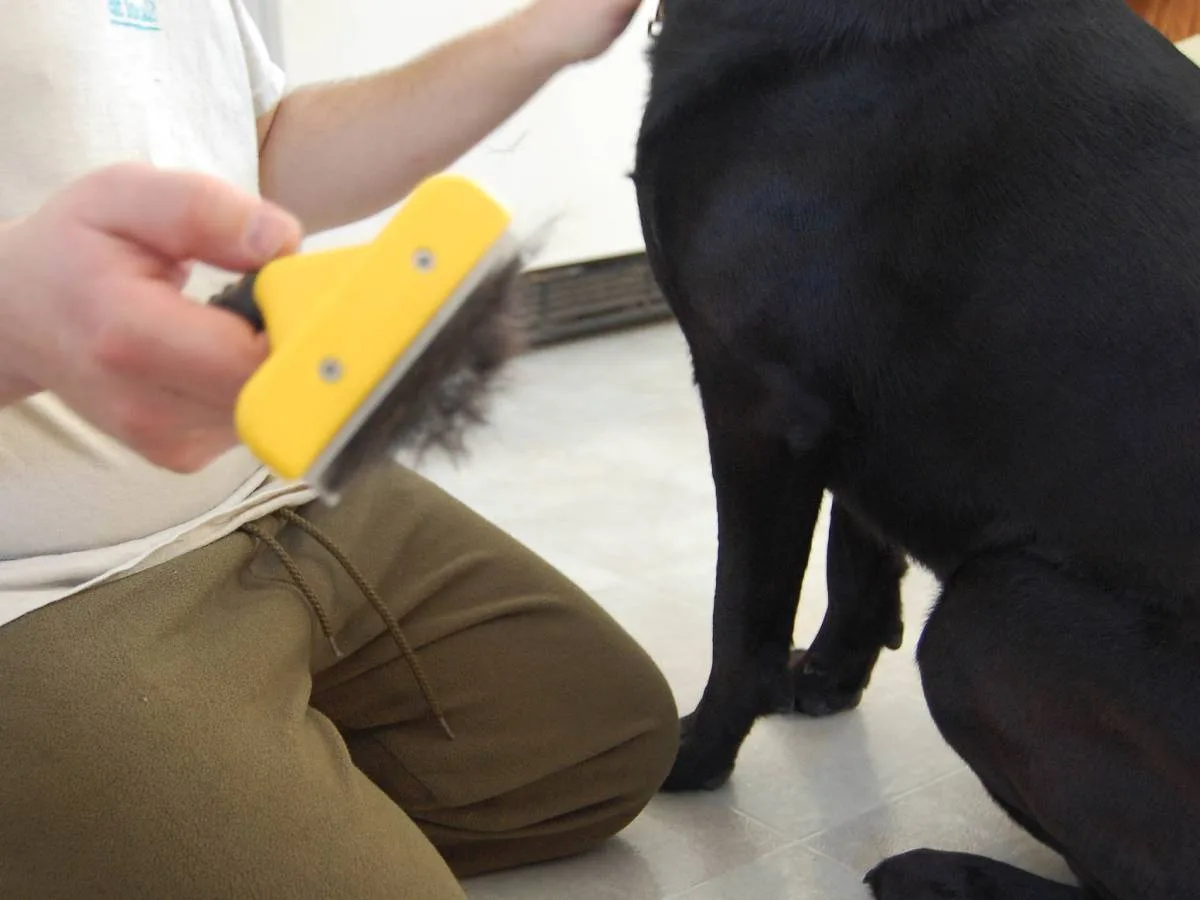
#6 – Trust me, the Furminator deShedding tool removes a LOT of loose pet hair! (Especially the very thick, but feathery undercoat fur.) You’ll want to choose a location that is easy to vacuum or sweep — like tile or hardwood floors. (I do all of our furminating on the porch when it’s nice outside. When it’s cold or rainy, I furminate my dogs on an easy-to-vacuum rug that’s on our hardwood floor near the back door.)
#7 – Since not all dogs have the same length of fur, there’s a different Furminator for short-haired dogs and long-haired dogs:
- Furminator for short hair – designed for dogs with hair shorter than 2 inches, the Furminator for short-haired dogs has shorter teeth on the metal edge — since there’s less hair to get through.
- Furminator for long hair – designed for dogs with hair longer than 2 inches, the Furminator for long-haired dogs has longer teeth on the metal edge — since there’s more hair to get through (both the outer coat and the undercoat).
#8 – The Furminator deShedding tool also comes in 5 different sizes (extra-small to giant size). What’s different with each one is the width of the brush and the number of teeth — smaller ones have fewer teeth and a narrower profile, while larger ones have more teeth and a wider profile.
Just in case you’re wondering… here’s a list of dogs that don’t shed much.
A Quick Word About Dog Shampoos…
Many years after I wrote this article about the Furminator dog brush, I discovered a great shampoo that helps to reduce the amount of shedding!
Interestingly, it’s also made by the Furminator company — but they didn’t recommend it to me or anything like that. Honestly, I was researching great smelling dog shampoos that have a lasting scent, and the Furminator deShedding shampoo came up with lots of positive reviews.
Turns out it’s good for more than just for its great and long-lasting scent… it really DOES reduce the amount of shedding on my dogs as well.
So now I use it faithfully during the summer months. And I use Wahl 4-in-1 Calming Dog Shampoo or Nature’s Specialties Silky Ultra Concentrated Conditioning Shampoo on the rare occasion that I need to bathe my dogs in the winter.
Like this post? Save it to read again later… or share with others on Pinterest!

